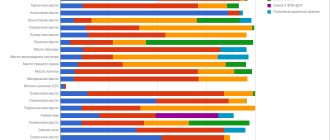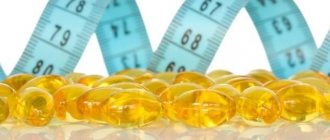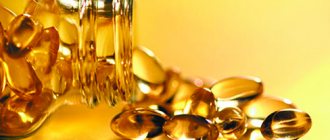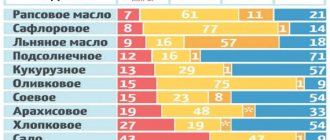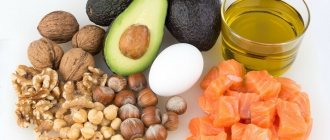The rapid growth and development of a child in the first year of life is usually ensured by mother's milk or adapted formulas, as well as the beginning of complementary feeding according to age. Fats occupy a special place in a baby's diet. They act as structural components of cell membranes and energy material.
Polyunsaturated fatty acids, or PUFAs, accumulate in the baby's body during its intrauterine development. The child receives them through the placenta, and subsequently through breast milk or adapted milk formulas.
Omega-3 polyunsaturated fatty acids are fundamentally important for the health and normal development of the child, and after breastfeeding - throughout the entire development period. By receiving them in sufficient quantities from food, the child develops harmoniously and correctly. But it is important to understand that the source of this type of polyunsaturated fatty acids, or PUFAs, is mainly fish. Do children need fish oil? Of course, if there is relatively little fatty sea fish in the child’s diet. But it is important to first discuss this issue with your pediatrician.
The benefits of fish oil for children's health
Fish oil is a source of essential fatty acids, which are the founders of omega-3 polyunsaturated fatty acids. They are essential and are not produced in the human body, but they play a huge role in the formation of phospholipids in cell membranes and the production of biologically active substances. Therefore, they must enter the body with food.
The main source of omega-3 PUFAs is marine fish oil. Eicosapentaenoic acid (EPA) and docosahexaenoic acid (DHA) are synthesized from alpha-linolenic acid. An important feature is that DHA is predominant in the gray matter of the human cerebral cortex.
Why do children need omega-3 acids? Long-chain polyunsaturated fatty acids are the basis for the structural and functional development of a child’s brain. It is known that the human brain is 60% fat, of which at least a third is represented by long-chain polyunsaturated fatty acids. In the early stages, they help the development of the visual analyzer.
Several proven effects of omega-3 acids:
- full development of the nervous system;
- improving the absorption of minerals by cells by improving the transport of calcium and magnesium through membranes;
- inhibition of the action of cyclooxygenase, which reduces the level of leukotrienes - substances that cause allergic and inflammatory processes.
The baby receives a supply of acids during intrauterine development, if they are present in sufficient quantities in the mother’s body. And this reserve is used up within a few months after birth. With a deficiency of PUFAs in infancy, disturbances in the functioning of the heart and blood vessels, problems with cholesterol, visual impairment, weak immunity, difficulties in learning and concentration may appear in later life.
Omega-3 acids also have the following effects:
- Reducing the production of platelet aggregation factor improves microcirculation and rheological properties of blood. Stimulation of nutrition of tissues of organs and systems.
- Improving elasticity, structure of vessel walls, normalizing the tone of blood vessels.
- Normalization of lipid (fat) metabolism, prevention of obesity. Reducing the level of triglycerides and low-density lipoproteins, increasing high-density lipoproteins.
Long-chain PUFAs ensure the normal development of motor and sensory functions. Their lack can lead to deviations in the physical and mental development of a child in infancy.
Fish oil and immunity
Many parents give fish oil for immunity to children on the recommendation of pediatricians. It can significantly improve a child’s well-being, help fight frequent respiratory diseases, and increase resistance to infections. This is especially important for children who attend kindergarten or often attend children's groups.
The benefits of fish oil in this case are also related to its composition, namely the presence of omega-3 fatty acids.
Omega-3 PUFAs break down into particularly important molecules: eicosanoids and docosanoids. The former are a group of biologically active compounds, including prostaglandins and leukotrienes. Eicosanoids perform the following roles:
- control the physiological systems of the body;
- regulate inflammation processes;
- regulate the immune response;
- participate in the processes of signal transmission by nerve cells.
Docosanoids activate neuroprotective and anti-inflammatory reactions. PUFAs inhibit the effect of anti-inflammatory cytokines at the site of inflammation and activate leukocytes. This allows us to conclude that a sufficient amount of omega-3 acids supplied with food or dietary supplements allows maintaining the normal functions of the child’s immune system. There are studies showing that regularly taking omega-3s reduces the incidence of bronchitis in children. This is the answer to the question of why children are given fish oil.
Fish oil in a child's diet
Fish oil is a natural bioproduct obtained from cod liver. The value of fish oil lies in its content, namely vitamin D and polyunsaturated fatty acids (Omega-3 and Omega-6).
Previously, 20-30 years ago, fish oil was necessarily given to children of primary and preschool age, since it did not exist in any other form, there were no adapted milk formulas, and sunny days, especially in Siberia, are not enough to produce our own vitamin D. Many people know that we need it for the absorption of calcium and normal growth and development of bone tissue, and also participates in the body’s metabolism. In turn, Omega-3 reduces the risk of developing cardiovascular diseases, the likelihood of developing diabetes, and preventing obesity.
Despite the positive properties of fish oil, its use is not so important in the modern world. In practice, vitamin D deficiency is not a common pathology. Newborns from 3-4 weeks of age are prescribed an aqueous or oily solution of vitamin D3 (Aqua D3 or Vigantol), so it is enough to drink 2-3 drops rather than drink fish oil with spoons, although fruit gummies and lozenges with various fruit flavors are currently produced . Another question arises: will this marmalade cause allergies?
In the pharmacy you can see not only fish oil¸ but also “fish” oil. These are two different forms. Fish oil mainly contains vitamins, while fish oil contains Omega fatty acids. Of course, it is better to take fish gelatin capsules. You can calculate the safe dosage yourself.
Children under 1.5 years old - 60 mg per kg of weight. Children aged 1.5 to 15 years – 30 mg per kg of weight. For a nursing mother - 300 mg per day, overdose should not be allowed, follow the instructions.
Foods rich in fatty acids: lake trout, tuna, salmon, mackerel, herring, sea bass, eel, haddock. Plant sources of Omega-3: walnut, avocado, flax and pumpkin seeds, oils (olive, flax, soybean, rapeseed, pumpkin). These products are not suitable for all children due to food allergens or contain toxic substances in fish due to environmental pollution.
Teenagers often use the “wrong” foods in their diet, such as fast food, hamburgers or sandwiches with soda water, which disrupts metabolism and leads to the development of obesity. Fish oil has a positive effect on metabolism, normalizes weight and reduces cholesterol levels in the blood.
Taking fish oil increases resistance to infections, stimulates the immune system, participates in mineral metabolism, namely the regulation of phosphorus and calcium, is responsible for the growth and mineralization of teeth and bone tissue, promotes the production of the happiness hormone - serotonin, improves memory, and reduces irritability.
Liver oil “fish oil” does not contain enough omega-3 fatty acids, most of all vitamins A and D, so it should be taken for no more than 2 months. In turn, Omega-3 “fish oil” can be combined with any multivitamins if necessary.
Preference should be given to the drug in gelatin capsules. Vitamin E as a preservative is added in liquid form and in large doses, an amount that, if used for a long time, is harmful to the growing organism.
Fish oil for children, as a rule, contains vitamins, dyes and sweeteners, and before you buy this product at the pharmacy, you need to make sure that all these additives are necessary. You also need to take into account age and whether your baby can swallow the capsule.
Fish oil from Norway is considered the highest quality and environmentally friendly product. The composition excludes toxins, salts of heavy metals, and petroleum products.
Pay attention to the date of manufacture of the drug. The shelf life of fish oil is 2 years and it is better to buy a recently manufactured product; it is impossible to guarantee storage rules and temperature conditions.
From all of the above, we can conclude: fish oil is useful, but in what form it is taken is everyone’s choice and like any other medicines, fish oil should be given to children only on the recommendation of your doctor, observing the dosage and duration of use.
The effect of fish oil on the cognitive-behavioral characteristics of a child
A lack of omega-3 acids has a proven role in the development of attention deficit hyperactivity disorder (ADHD). Therefore, the question of why children need fish oil has an obvious answer - supplementing the diet with it helps compensate for behavioral problems and learning difficulties. Research shows that almost half of children who regularly consume omega-3s have improved their reading and writing abilities. How it works?
Omega-3 acids are absorbed by the membranes of nerve cells and neurons. Impulses are better transmitted between them, and the function of receptors located on the membranes of neurons improves. Omega-3s are involved in the formation of nerve cells, the restoration of neurons and their environment, the prevention of damage to nervous tissue, and protection from oxidative stress. That is why fish oil, namely the PUFAs it contains, is so necessary for the development of the baby’s brain.
Many researchers have noted a significant relationship between increasing docosahexaenoic acid (DHA) levels and improving performance on attention tests. Therefore, PUFAs affect the cognitive abilities of children, improve cognitive processes, and participate in the maintenance and timely development of thinking processes.
Which fish oil to choose and at what age to take it
A lack of PUFAs cannot always be eliminated by adjusting the diet. Kids who are picky eaters may simply refuse to eat fish frequently. In addition, it is important to remember that fish proteins are quite a powerful allergen. And often a nursing mother is forced to refuse fish and seafood, and subsequently she introduces fish as complementary foods a little later. If an allergic reaction is detected in a child, this group of products must be abandoned altogether. Therefore, many experts prefer prescribing special complexes containing omega-3 fatty acids. It is important to understand that modern fish oil may not have a specific smell or taste at all. For example, Lysi children's fish oil has a pleasant taste and aroma.
Which fish oil is best for children is determined individually. Today, there is a wide selection of supplements supplemented with vitamins, minerals and other beneficial substances to improve metabolic processes, support vital functions and child development.
Fish oil fortified with vitamins A and D can produce impressive results. Vitamin A is essential for normal skin, vision, bone development and the immune system. It enhances the biological activity of omega-3, slows down cell damage, being a natural antioxidant.
Vitamin D is required by the child's body to maintain the required levels of calcium and phosphate. It also enhances the effect of omega-3 acids.
At what age can a doctor prescribe fish oil for children? As a rule, supplementing the diet with this product is relevant from the age of three. However, each case is individual, so it is worth consulting with your pediatrician.
How much fish oil should you take?
There is no recommendation regarding the amount of fish oil you should take.
However, there are recommendations for total omega-3 intake, as well as EPA and DHA.
The recommended daily intake (RDI) of combined EPA and DHA is 250-500 mg (, ).
Related articles:
- Astaxanthin: what are the benefits for the body of women and...
- Restoring the female cycle with seeds
When purchasing fish oil supplements, be sure to read the label to determine how much EPA and DHA your supplement contains. Typically, 1000 mg of fish oil contains about 300 mg of combined EPA and DHA ().
General recommendations for taking fish oil for adults
The daily intake of omega-3 is 1100 mg for women and 1600 mg for men ().
Most people get omega-3 in their diet from foods such as flax seeds, soybean oil and walnuts. But they do contain ALA.
While the human body can convert ALA into EPA and DHA, adequate levels of these fatty acids cannot be produced on its own. To do this, you will need to eat just a huge amount of flaxseeds or walnuts. The best way out is about two servings of 250 grams of oily fish per week. In this case, both EPA and DHA (, ,) may be enough for you.
Generally, up to 3,000 mg of fish oil daily is considered a safe amount for adults to consume ().
Best Fish Oil on iHerb.com:
Minami Nutrition, Garden of Life Omega-3 Fish Oil, Orange Flavor, 60 Capsules (take one capsule daily)
Carlson Labs, Norwegian Salmon Oil, 500 mg, 180 Softgels +50 Softgels Free (Take Two Capsules Daily)
Carlson Labs, Cod Liver Oil, Super 1000 mg, 250 Softgels (take one capsule daily)
Carlson Labs, Wild Norwegian Cod Liver Oil, Natural Lemon Flavor, 8.4 oz (250 ml) (take one teaspoon daily)
Now Foods, Ultra Omega 3-D, 180 Softgels
Wiley's Finest, Alaskan Fish Oil, Minicapsules (Easy to Swallow), 450 mg, 60 Softgels
Best DHA Ratio
Nordic Naturals, DHA, Strawberry Flavor, 500 mg, 90 Softgels
Nordic Naturals, Arctic Cod Liver Oil, Lemon, 1,000 mg, 180 Softgels
Carlson Labs, Wild Norwegian Cod Liver Oil, Lemon, 16.9 fl oz (500 ml)
During pregnancy
EPA and DHA are essential for normal fetal development. DHA in particular accumulates in the brain during the last trimester of pregnancy (, ). However, many pregnant women do not consume the daily requirement of these fatty acids ().
Taking EPA and DHA supplements during pregnancy may also benefit your baby during infancy and childhood. Potential benefits include improved problem-solving skills and a reduced risk of asthma and food allergies (, ,).
WHO recommends that pregnant women take 300 mg of combined EPA and DHA per day - 200 mg of which should be DHA ().
Best fish oil for pregnant women on iHerb.com:
Nordic Naturals, Pregnancy DHA, Unflavored Formula, 500 mg, 180 Softgels
Since most fish oil supplements contain more EPA than DHA, you should try to find one with a higher DHA ratio ().
Be careful with fish oil during pregnancy as it contains high amounts of vitamin A. Too much vitamin A can impair fetal development. Follow the dosage!
Just 1 teaspoon (4 ml) of cod liver oil provides 2,501 IU of vitamin A, which is about 97% of the daily value during pregnancy (, ,).
Babies and children
The adequate intake of omega-3 for infants under 1 year of age is 500 mg. The norm gradually increases to adult consumption by age 14 ().
Likewise, recommendations for EPA and DHA vary by age. For example, about 100 mg of combined EPA and DHA is required for a 4-year-old child, and an 8-year-old child requires about 200 mg ().
Fish oil for children also naturally provides some vitamins, especially A and D, as these are stored in the fish's liver. It also contains vitamin E, which keeps the oil stable and can extend shelf life.
Best Fish Oil for Children on iHerb.com:
Nordic Naturals, Children's DHA, Strawberry, 4 fl oz (119 ml) (for children under 4 years, take 1/2 teaspoon daily)
Nordic Naturals, DHA Junior, Great for Kids 3+, Strawberry Flavor, 4 fl. oz. (119 ml) (for children over 3 years old, take 1/2 teaspoon per day)
When purchasing children's fish oil supplements, try to find ones that are specific to that stage of life to ensure the correct amount of nutrients is provided.
Although there are general recommendations for EPA and DHA for healthy adults, pregnant women, as well as infants and children, have different needs and recommendations for how much fish oil to take per day.


